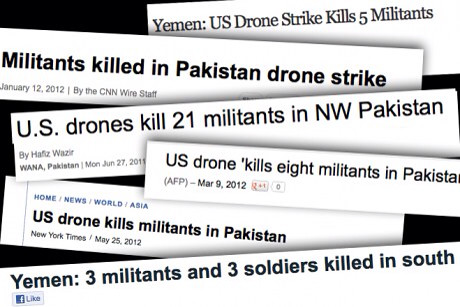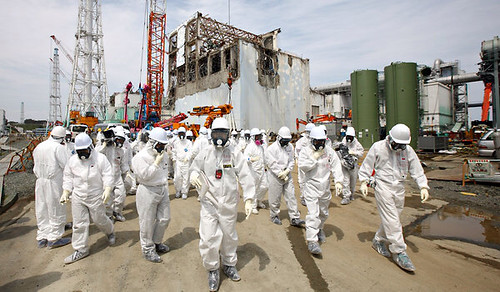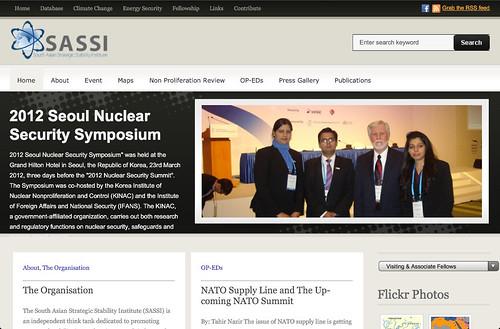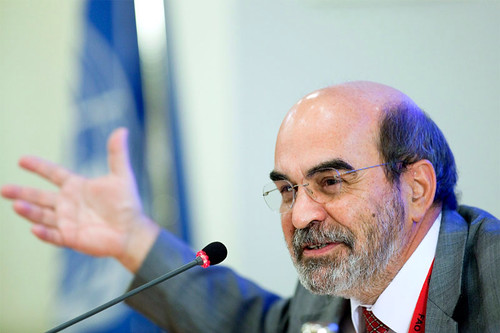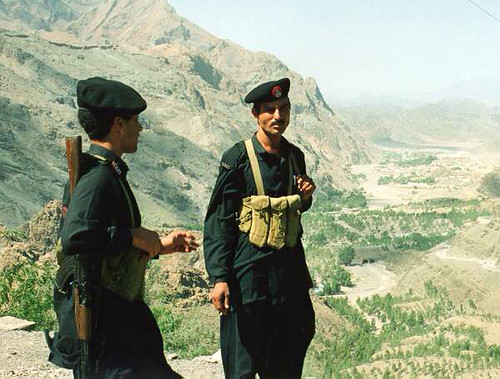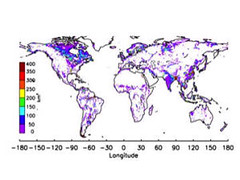SASSI is an independent think tank dedicated to promoting peace and stability in South Asia. We are headquartered in Islamabad, Pakistan and we aim to make a leading contribution to regional and international academic and policy-orientated research discourses about South Asian security.
Wednesday, May 30, 2012
Afghanistan: Mind the God gap
Yet there is a glaring gap in this conversation, one that ignores the on-the-ground reality of Afghanistan. It is the role of religion and its influence on the trajectory of the Afghan government. By paying it little or no heed, the United States is omitting a key piece of the complex jigsaw puzzle that is Afghanistan's future.
My meeting with Afghan Minister of Justice Habibullah Ghalib in Kabul drove home the importance of religion and its influence on matters of state. Our conversation in December 2010 quickly turned to the application of Islamic religious law to the affairs of men and women, especially the issue of apostasy, a topic which places core freedoms of religion and conscience at the center of government policy. At the time, a convert to Christianity was being detained, but similar cases had arisen where Muslims were charged with "criminal" activity considered blasphemous. He justified government actions on Islamic law, brushing aside my counterarguments for freedom of religion and belief based on international standards, the Afghan constitution, and even Qur'anic references.
It wasn't surprising that the Minister was unmoved in his view that apostasy and blasphemy were crimes to be punished by the state, as it reflected past Afghan government actions against Muslims and non-Muslims to stifle freedom of thought and restrict expression. However, it underscored the cost of not addressing the role of religious tenets in law and governance.
Afghanistan's legal system is a big part of the problem, despite Article 7 of the Afghan constitutionstating that the Afghan government "shall abide by" the Universal Declaration on Human Rights. In practice, Afghanistan has established a restrictive interpretation of Islamic law through the vague repugnancy clause in Article 3 that states that "no law can be contrary to the beliefs and provisions of the sacred religion of Islam." Consequently, there are no protections for individuals to dissent from state-imposed orthodoxy, debate the role of religion in law and society, advocate for the human rights of women and religious minorities, or question interpretations of Islamic precepts.
David Ignatius' "unthinkable" thought of a Taliban return to Kabul could happen, but perhaps even faster than he imagines. The Afghan constitution's provisions referencing undefined notions of Islamic law give Taliban sympathizers legal cover to apply their regressive religious interpretations through laws against human rights, religious freedom, and women's rights.
Religion matters in Afghanistan, and promoting religious freedom and tolerance can help achieve human rights and security goals. Repression of religious freedom strengthens the hand of violent religious extremists. As I've written elsewhere, conditions of full religious freedom allows for the peaceful sharing of differing views and interpretations. This openness can displace extremist influences from social and religious networks, thereby limiting their ability to influence populations of concern and turn them towards violence. Recent studies and research are building an empirical case that limitations on religious freedom lead to more, not less, societal instability. More
Militants”: media propaganda
Virtually every time the U.S. fires a missile from a drone and ends the lives of Muslims,American media outlets dutifully trumpet in headlines that the dead were ”militants” – even though those media outlets literally do not have the slightest idea of who wasactually killed. They simply cite always-unnamed “officials” claiming that the dead were “militants.” It’s the most obvious and inexcusable form of rank propaganda: media outlets continuously propagating a vital claim without having the slightest idea if it’s true.
This practice continues even though key Obama officials have been caught lying, a term used advisedly, about how many civilians they’re killing. I’ve written and said many times before that in American media discourse, the definition of “militant” is any human being whose life is extinguished when an American missile or bomb detonates (that term was even used when Anwar Awlaki’s 16-year-old American son, Abdulrahman, was killed by a U.S. drone in Yemen two weeks after a drone killed his father, even though nobody claims the teenager was anything but completely innocent: “Another U.S. Drone Strike Kills Militants in Yemen”).
This morning, the New York Times has a very lengthy and detailed article about President Obama’s counter-Terrorism policies based on interviews with “three dozen of his current and former advisers.” I’m writing separately about the numerous revelations contained in that article, but want specifically to highlight this one vital passage about how the Obama administration determines who is a “militant.” The article explains that Obama’s rhetorical emphasis on avoiding civilian deaths “did not significantly change” the drone program, because Obama himself simply expanded the definition of a “militant” to ensure that it includes virtually everyone killed by his drone strikes. Just read this remarkable passage: More"Al Qaeda is an insular, paranoid organization" [Interestingly, this is a fair description of recent American administrations]
Monday, May 28, 2012
Security researcher: I found secret reprogramming backdoors in Chinese microprocessors
Claims were made by the intelligence agencies around the world, from MI5, NSA and IARPA, that silicon chips could be infected. We [Canbridge Computer Lab]
developed breakthrough silicon chip scanning technology to investigate these claims. We chose an American military chip that is highly secure with sophisticated encryption standard, manufactured in China. Our aim was to perform advanced code breaking and to see if there were any unexpected features on the chip. We scanned the silicon chip in an affordable time and found a previously unknown backdoor inserted by the manufacturer. This backdoor has a key, which we were able to extract. If you use this key you can disable the chip or reprogram it at will, even if locked by the user with their own key. This particular chip is prevalent in many systems from weapons, nuclear power plants to public transport. In other words, this backdoor access could be turned into an advanced Stuxnet weapon to attack potentially millions of systems. The scale and range of possible attacks has huge implications for National Security and public infrastructure.
Key features of our technology:
* scans silicon/hardware for backdoors, Trojans and unexpected behaviour
* low cost
* very fast result turnaround time
* high portability
* adaptable - scale up to include many types of chip
Further funding is needed for us to progress to testing further silicon chips and to develop better search algorithms which would allow us to detect possible spy systems or vulnerabilities in a greater range of systems.
Currently there is no economical or timely way of ascertaining if a manufacturer's specifications have been altered during the manufacturing process (99% of chips are manufactured in China), or indeed if the specifications themselves contain a deliberately inserted potential threat. More
Cambridge Paper here PDF
Robert Fisk: The going price of getting away with murder... would $33m be enough?
Monday, 28 May 2012
La Clinton hath spoken. Thirty-three million smackers lopped off Pakistan's aid budget because its spooks banged up poor old Dr Shakeel Afridi for 33 years after a secret trial. And, as the world knows, Dr Afridi's crime was to confirm the presence of that old has-been Osama bin Laden in his grotty Abbottabad villa.
Well, that will teach the Pakistanis to mess around with a brave doctor who is prepared to help the American institution that tortures and murders its enemies. Forget the CIA's black prisons and rendition and water-boarding, and the torture of the innocents in the jails of our friendly dictators. Dr Afridi was just doing the free world a favour. And WOW, Dr Afridi got shopped by Leon Pannetta when he was CIA boss, and now Barack Obama is accused of letting him down.Well, I pause here. Dr Afridi was brought before a secret trial in the Khyber tribal area – no charge sheets, no lawyers, no statements from the defendant or the prosecution, just a measly accusation of conspiracy against the state of Pakistan and "high treason". I've never known the difference between "treason" and "high treason" but – since Pakistan's security apparatus is a mirror image of the British Empire – I assume it was invented by us. "High treason" means treason against the monarch. By fingering Bin Laden, after using a ruse about vaccinating his family against hepatitis B to gain access to him, Dr Afridi was committing treason against King Asif Ali Zardari, otherwise known as the President of Pakistan.
But hold on a moment. Let's suppose Vladimir Putin sent a KGB/FSB hit squad to Britain to murder a former agent called Alexander Litvinenko who had turned against his old spymasters. And let's suppose that the Russians murdered Litvinenko. Which – in real life – they did. And Litvinenko – in real life – was indeed a trusted agent of the Russians, just as Bin Laden was a much-admired servant of the CIA when he was fighting the Russians in Afghanistan.
Getting a bit close to home? Well, let's go a stage further. Supposing Litvinenko was murdered after being identified by a friendly British GP – working for the KGB/FSB – who vaccinated the Litvinenko family against hep B. What do Messrs Cameron and Clegg and the Commissioner of the Metropolitan Police and the Lord Chief Justice and the Lord High Executioner and all the other nabobs do? Do they accuse the British GP of treason, clap him in irons, stage a hush-hush trial covered by the Official Secrets Act and send the chap off to rot in the Tower of London for – say – 33 years? More
Sunday, May 27, 2012
Spent fuel rods drive growing fear over plant in Japan
Fourteen months after the accident, a pool brimming with used fuel rods and filled with vast quantities of radioactive cesium still sits on the top floor of a heavily damaged reactor building, covered only with plastic.
The public’s fears about the pool have grown in recent months as some scientists have warned that it has the most potential for setting off a new catastrophe, now that the three nuclear reactors that suffered meltdowns are in a more stable state, and as frequent quakes continue to rattle the region.
The worries picked up new traction in recent days after the operator of the plant, Tokyo Electric Power Company, or Tepco, said it had found a slight bulge in one of the walls of the reactor building, stoking fears over the building’s safety.
To try to quell such worries, the government sent the environment and nuclear minister to the plant on Saturday, where he climbed a makeshift staircase in protective garb to look at the structure supporting the pool, which he said appeared sound. The minister, Goshi Hosono, added that although the government accepted Tepco’s assurances that reinforcement work had shored up the building, it ordered the company to conduct further studies because of the bulge.
Some outside experts have also worked to allay fears, saying that the fuel in the pool is now so old that it cannot generate enough heat to start the kind of accident that would allow radioactive material to escape.
But many Japanese scoff at those assurances and point out that even if the building is strong enough, which they question, the jury-rigged cooling system for the pool has already malfunctioned several times, including a 24-hour failure in April. Had the outages continued, they would have left the rods at risk of dangerous overheating. Government critics are especially concerned, since Tepco has said the soonest it could begin emptying the pool is late 2013, dashing hopes for earlier action.
“The No. 4 reactor is visibly damaged and in a fragile state, down to the floor that holds the spent fuel pool,” said Hiroaki Koide, an assistant professor at Kyoto University’s Research Reactor Institute and one of the experts raising concerns. “Any radioactive release could be huge and go directly into the environment.” More
Friday, May 25, 2012
Wednesday, May 23, 2012
Combat Exoskeleton Marches Toward Afghanistan Deployment
At least, that’s what a Lockheed rep indicated today at a Special Forces trade show in Tampa. Asked if there were plans to deploy the HULC exoskeleton overseas following its next round of Army testing, Lockheed’s special operation program manager Keith Maxwell nodded yes and said, “after that.”
Maxwell was wearing what he described as a “smaller, lighter, more energy-efficient” version of the battery-powered external skeleton, complete with an unloaded machine gun on a pivoting mechanical arm. He asked us not to photograph the exoskeleton, but he was happy to discuss it.In essence, HULC adds an artificial, external spine, hips, legs and the aforementioned pivoting arm to a soldier’s flesh and bones. The machine extremities, powered by a lithium-ion battery, redistribute and transfer up to 200 pounds of weight down and off the wearer’s body, allowing him to carry more, longer. “There’s a 10 percent metabolic cost for the benefit of a heavy load removed,” Maxwell says.
Add loads of food, water, batteries and other supplies, and you become a human pack mule for your squadmates. Swap them out for a heavy machine gun and you transform into what Maxwell calls a “one-man crew-served weapon.” Maxwell says he live-fired his machine gun just before the trade show and “felt the recoil eliminated down to one-third.” More
Starship Troopers: Don't go far from our power supply for if your batteries die you are toast. It looks very tiring as the users stride seems unusual, which may cause falls on uneven ground. Editor
Conference: Standards of Education for 21st Century Pakistan
A one day National Conference on Setting Standards for 21st Century Pakistan was organized by Higher Education Commission and the South Asian Strategic Stability Institute SASSI to explain the role being played by HEC in developing Higher Education in the country. SASSI was the official sponsor for this conference and Director General Dr. Maria Sultan chaired a session during the conference. The theme of the conference was to demonstrate the role played by HEC in various direction of country’s development towards self sufficiency. First Panel explained the role of HEC in providing skilled and qualified manpower which is being utilized in various fields of national economy and is being used for Research, Innovation and Industry.
During the presentations, Panel participants also elaborated the role being played by the universities in building and developing the sustainable economy every where in the world in general and in Pakistan in particular. It was in this session, that the quality of research being carried out in these universities was demonstrated in the exhibition hall, where representatives of various large as well as medium scale institutes exhibited their research products and innovative ideas. Participants of second panel gave their presentations on the long term goal being achieved by the universities under the banner of HEC.
The presenters argued that implementation of guide lines given to universities by HEC planners has provided the base for arming the youth or future leaders of Pakistan with most sophisticated knowledge of various sciences which has enabled them to share their efforts for country’s progress and prosperity. Similarly, such initiatives have transformed the rigid societies into modern and elastic communities, which is all because of the central role of HEC that has revolutionized the country’s higher education system. The Third Panel participants came up with the theme of HEC as playing the most important role for “Provincial Harmony” in the country, thus recognizing the status of HEC as of a central pillar in country’s higher education system, making it necessary to remain functioning as an institution of central level. SASSI participated in the event with all of its team under the leadership of Director General Dr. Maria Sultan. More
Sunday, May 20, 2012
what CNN dosen't want you to see again
starting at 3 minutes and 30 seconds.
Saturday, May 19, 2012
New UN-backed guidelines aim to protect rights to land, fisheries and forests
“Giving poor and vulnerable people secure and equitable rights to access land and other natural resources is a key condition in the fight against hunger and poverty,”said the Director-General of the UN Food and Agriculture Organization (FAO), José Graziano da Silva.
“It is a historic breakthrough that countries have agreed on these first-ever global land tenure guidelines,” he added. “We now have a shared vision. It’s a starting point that will help improve the often dire situation of the hungry and poor.”
The new Voluntary Guidelines on the Responsible Governance of Tenure of Land, Fisheries and Forests in the Context of National Food Security was adopted by the Committee on World Food Security (CFS) – the leading global platform for discussions on food security issues – in Rome earlier on Friday.
Among the issues dealt with in the guidelines is the so-called ‘land-grabbing’ phenomenon, according to a news release issued by FAO. It recommends that safeguards be put in place to protect tenure rights of local people from risks that could arise from large-scale land acquisitions, and also to protect human rights, livelihoods, food security and the environment.
The guidelines also address a wide range of other issues such as recognition and protection of legitimate tenure rights, even under informal systems; best practices for registration and transfer of tenure rights; making sure that tenure administrative systems are accessible and affordable; managing expropriations and restitution of land to people who were forcibly evicted in the past; and the rights of indigenous communities. More
Thursday, May 17, 2012
Western diplomats are still getting it wrong on Iran
The outcome of talks between Iran and the P5+1 (France, Germany, Russia, UK, US and China) in Istanbul back in April gave hope to those who believe that war is no solution to the dispute with Iran. But, a month later, it's already unclear whether the west intends to honour promises made in Istanbul.
Lady Ashton has informed reporters of her expectations for another round of talks between Iran and P5+1 on 23 May: "My ambition is that we come away with the beginning of the end of the nuclear weapons programme in Iran." Her words give a hint of how western diplomats still struggle to understand the Iranian mindset. Iranians have repeatedly staked their honour on their assurance that Iran does not want nuclear weapons. The IAEA, US intelligence experts and Israeli intelligence experts are agreed that Iran is not building nuclear weapons and has not decided to do so.
Diplomatic blunders like this one can at least be put right by a further statement. The failure to honour promises, however, will deliver a mortal blow to the negotiating process launched last month.
At talks in Istanbul in April, it had been announced that discussions would be guided by the principles of reciprocity and a step-by-step approach. Most observers understood this to mean that the fruit of negotiations would be harvested at intervals, and that each harvest would consist of two baskets of concessions, roughly equal in value.
To put it simply, the Iranian basket would contain measures extending beyond those Iran is required to concede, and has conceded, as a party to the nuclear non-proliferation treaty (NPT) – in order to increase western and Israeli confidence that Iran will not divert nuclear material to a clandestine military programme. The P5+1 basket, on the other hand, would mainly contain sanctions "relief" and the progressive lifting of the sanctions that the US, EU and UN have heaped on to Iran's back since 2006.
Yet now the terms of the bargain appear to have changed. According toan Iran specialist at the Brookings Institution, quoted in the Christian Science Monitor, US administration officials are saying: "Sanctions relief is not on the table unless and until we see substantial Iranian concessions." This does not sound like an approach "guided by the principle of reciprocity". From a European capital, meanwhile, comes a report that the EU is reluctant to accept that initial Iranian concessions will have to be bought through substantial sanctions relief or removal.
The US has always been likely to find the removal of sanctions problematic. The authority to lift US sanctions rests with Congress, not the administration. Anti-Iranian feeling is strong in Congress. Getting Congress to agree to sanctions removal is going to be a hard slog. But the administration has latitude to offer sanctions relief. More
Pakistan's climate change challenge
Siachen is rife with glacial melt; one study concludes the icy peak has retreated nearly two kilometers in less than 20 years. It has also been described as "the world's highest waste dump." Much of this waste-generated from soldiers' food, fuel, and equipment-eventually finds its way to the Indus River Basin, Pakistan's chief water source.
Siachen, in fact, serves as a microcosm of Pakistan's environmental troubles. The nation experiences record-breaking temperatures, torrential rains (nearly 60 percent of Pakistan's annual rainfall comes from monsoons), drought, and glacial melt (Pakistan's United Nations representative, Hussain Haroon, contends that glacial recession on Pakistani mountains has increased by 23 percent over the past decade). Experts estimate that about a quarter of Pakistan's land area and half of its population are vulnerable to climate change-related disasters, and several weeks ago Sindh's environment minister said that millions of people across the province face "acute environmental threats."
The last two years have provided ample proof of Pakistan's climate-change vulnerability. According to climatologists, the devastating floods of 2010-which submerged a fifth of the country and displaced millions-constituted "the worst natural disaster to date attributable to climate change" (a judgment rendered in 2010). They argued that a combination of high temperatures in the Atlantic Ocean and lower ones in the Pacific "created the perfect conditions" for the deluge.Pakistan's environmental insecurity is not merely a matter of nasty weather. In three specific ways, it also threatens the country's fragile stability.
The floods' destructiveness was exacerbated by Pakistan's rampant deforestation. UN data andPakistani media reports paint an alarming picture of this emissions-releasing scourge: Pakistan suffers from the highest annual rate of deforestation in Asia (the nation lost 33 percent of its forest cover between 1990 and 2010), with barely 2 percent of the country's total area remaining forested today. One of the prime perpetrators is the Pakistani Taliban, which has long recognized the revenue-generating potential of logging. During its rule over Swat in northern Pakistan, the Taliban's timber sales eliminated up to 15 percent of the picturesque region's forest cover. Separately, back in the 1990s, wealthy landowners in Sindh ordered laborers to clear forestland for crop cultivation; one small village alone lost 10,000 acres of forest. In both Swat and Sindh, the loss of forestland has facilitated riverbank erosion and deprived the country of a natural bulwark against raging floodwaters. More
Wednesday, May 16, 2012
Self-Worth Shattering: A Single Bomb Blast Can Saddle Soldiers with Debilitating Brain Trauma
The stress and suffering of combat are known to leave a lasting impact on military veterans, in some cases triggering post-traumatic stress disorder (PTSD). Researchers have now found an even more serious and debilitating mental condition, known as chronic traumatic encephalopathy(CTE), in veterans, particularly those injured by the concussive force of bomb blasts.
Whereas PTSD is a mental illness, marked by unwelcome flashbacks and anguish, CTE is a progressive neurodegenerative brain disorder characterized by abnormal protein deposits that eventually kill brain cells and thus cause cognitive declines, including loss of memory and the ability to learn as well asdepression. The number of veterans at risk is large: traumatic brain injury caused by explosive blasts is thought to afflict about 20 percent of the 2.3 million servicemen and women deployed in combat since 2001, according to a team of researchers from Boston University, New York Medical College and the Veterans Affairs Boston Healthcare System.
These researchers say they have demonstrated that exposure to a single blast equivalent to that generated by a typical improvised explosive device (IED) can result in CTE and long-term brain impairments that accompany the disease. The research, published online Wednesday in Science Translational Medicine, also indicates that soldiers are injured by more than just the initial shock wave of very high air pressure following a blast. An IED's secondary "blast wind," a huge volume of displaced air flooding at high pressure back into the vacuum, can also damage the brain and lead to long-term consequences such as CTE. The blast wind created by an IED can reach a velocity of more than 530 kilometers per hour. Winds from a category 5 hurricane (the most severe), by comparison, reach about 250 kilometers per hour. More
Tuesday, May 15, 2012
Pakistan agrees to reopen NATO supply route to Afghanistan, but for a fee
The accord, which the Pakistani government announced late Tuesday, would revive the transport of vital supplies of food and equipment from Pakistani ports overland to land-locked Afghanistan. In return, the U.S.-led coalition will pay Pakistan a still-to-be-fixed fee of $1,500 to $1,800 for each truck carrying supplies, a tab that officials familiar with negotiations estimated would run nearly $1 million a day. The officials requested anonymity because they weren’t authorized to reveal details of the agreement.
Pakistan closed the land route to supplies headed to the coalition after American aircraft mistakenly attacked two Pakistani border outposts Nov. 26, killing 24 Pakistani soldiers. Since then, supplies for coalition forces in Afghanistan have passed through one of two routes that stretch from Afghanistan through central Asia and Siberia to Georgia on the Black Sea. One of the routes is nearly 6,000 miles long. The Pakistan route is less than 500 miles.
Officials in Washington said they didn’t know how much of the new cost the United States would bear. As the United States contributes more than two-thirds of the 130,000-strong international force, which operates under the command of NATO, it’s expected that Washington will pay most of the new fee.
In return, the U.S. is asking Pakistan to provide security for the supplies, which are trucked through the country by private local transport companies, and much speedier clearance of customs and checkpoints. Militants and robbers frequently attack trucks carrying NATO goods. No effective security had been provided in the past. More
Read more here: http://www.mcclatchydc.com/2012/05/15/148936/pakistan-agrees-to-reopen-nato.html#storylink=cpy
E
Read more here: http://www.mcclatchydc.com/2012/05/15/148936/pakistan-agrees-to-reopen-nato.html#storylink=cpy
Monday, May 14, 2012
America As A Shining Drone Upon A Hill
Here’s the essence of it: you can trust America’s crème de la crème, the most elevated, responsible people, no matter what weapons, what powers, you put in their hands. No need to constantly look over their shoulders.
Placed in the hands of evildoers, those weapons and powers could create a living nightmare; controlled by the best of people, they lead to measured, thoughtful, precise decisions in which bad things are (with rare and understandable exceptions) done only to truly terrible types. In the process, you simply couldn’t be better protected.
And in case you were wondering, there is no question who among us are the best, most lawful, moral, ethical, considerate, and judicious people: the officials of our national security state. Trust them implicitly. They will never give you a bum steer.
You may be paying a fortune to maintain their world — the 30,000 people hired to listen in on conversations and other communications in this country, the 230,000 employees of the Department of Homeland Security, the 854,000 people with top-secret clearances, the 4.2 million with security clearances of one sort or another, the $2 billion, one-million-square-foot data center that the National Security Agency is constructing in Utah, the gigantic $1.8 billion headquarters the National Geospatial Intelligence Agency recently built for its 16,000 employees in the Washington area — but there’s a good reason. That’s what’s needed to make truly elevated, surgically precise decisions about life and death in the service of protecting American interests on this dangerous globe of ours.
And in case you wondered just how we know all this, we have it on the best authority: the people who are doing it — the only ones, given the obvious need for secrecy, capable of judging just how moral, elevated, and remarkable their own work is. They deserve our congratulations, but if we’re too distracted to give it to them, they are quite capable of high-fiving themselves.
We’re talking, in particular, about the use by the Obama administration (and the Bush administration before it) of a growing armada of remotely piloted planes, a.k.a. drones, grimly labeled Predators and Reapers, to fight a nameless, almost planet-wide war (formerly known as the Global War on Terror). Its purpose: to destroy al-Qaeda-in-wherever and all its wannabes and look-alikes, the Taliban, and anyone affiliated or associated with any of the above, or just about anyone else we believe might imminently endanger our “interests.” More
Sunday, May 13, 2012
Protect New START
By a narrow 34-28 margin, Republicans on the House Armed Services committee pushed through a 48-page amendment offered by Rep. Michael Turner, R-Ohio, to the National Defense Authorization Act that would block funding for New START implementation unless higher spending targets for nuclear weapons production facilities set in 2010 are met in future years.
This type of partisan “hostage taking” threatens to undermine U.S. national security, and it ignores the fact that there is bi-partisan agreement among congressional appropriators that additional nuclear weapon budget increases are unaffordable and unnecessary.If Rep. Turner’s provision to tie up New START were to become law, Russia would likely halt its nuclear reductions as well, risking the treaty’s collapse. This would allow Moscow to rebuild its nuclear forces above the treaty ceiling of 1,550 deployed strategic warheads and increase the number of nuclear weapons aimed at the U.S.
Moreover, the inspection system established under the treaty could collapse, depriving the U.S. of crucial data exchanges and on-site inspections of Russian forces, undermining transparency and strategic stability. More
Saturday, May 12, 2012
Population Pressure Impacts World Wetlands
These are the conclusions of a study conducted by CNRS and IRD researchers from the Laboratoire d'étude du rayonnement et de la matière en astrophysique (CNRS / Observatoire de Paris / UPMC / Université de Cergy-Pontoise / ENS), Laboratoire d'études en géophysique et océanographie spatiales (CNRS / IRD / CNES / Université Toulouse III-Paul Sabatier) and the start-up Estellus.* To obtain these results, the scientists performed the first worldwide mapping of the wetlands and their temporal dynamics, for the years 1993 to 2007.
This study, which has just been published in the journal Geophysical Research Letters, emphasizes the impact of population pressure on water cycles.
SMarshes, lagoons, swamps and bogs are all types of wetlands -- regions where water is the main controlling factor for the environment and its plant and animal life. Although they cover less than 5% of Earth's land surface, these areas play a key role in human activities, biodiversity, climate and the water cycle. Indeed, they produce one third of atmospheric methane, a major greenhouse gas. Moreover, these regions impact the transfer of continental freshwater to the sea and alter local weather by enhancing evaporation. More
In Afghanistan it is 1984 and 'Big Brother' is watching
“It is there every day except the days when it is windy and rainy,” said Suleman, 45, who goes by only one name.
“It watches us day and night,” said another trader, Mir Akbar, 18, his eyes following the balloon as its nose swiveled with the wind from east to west.
“I notice it all the time,” said Rahmat Shah, 28, a secondhand car seller, who was standing slightly aside from the other men. “I know there is a camera in it.”
The dirigible, a white 117-foot-long surveillance balloon called an aerostat by the military, and scores more like it at almost every military base in the country, have become constant features of the skies over Kabul and Kandahar, and anywhere else American troops are concentrated or interested in.
Shimmering more than 1,500 feet up in the daytime haze, or each visible as a single light blinking at night, the balloons, with infrared and color video cameras, are central players in the American military’s shift toward using technology for surveillance and intelligence.
In recent years, they have become part of a widening network of devices — drones, camera towers at military bases and a newer network of street-level closed-circuit cameras monitoring Kabul’s roads — that have allowed American and Afghan commanders to keep more eyes on more places where Americans are fighting.
The dirigibles are now such a common feature in daily Afghan life that some people here shrug and say they hardly notice them. Other parts of the network have become lasting parts of the urban landscape as well, particularly in Kabul, where long-necked closed-circuit cameras overlook locations susceptible to attacks, like the Supreme Court building, traffic circles and main highways past the military camps.
But other Afghans describe a growing sense of oppression, the feeling that even as the Americans are starting to pack up to leave, the foreigners’ eyes will always be on them.More
Thursday, May 10, 2012
Europe's Dirty Little Secret
Top U.S. Officer: Stop This ‘Total War’ on Islam Talk
“It was totally objectionable, against our values and it wasn’t academically sound,” Army Gen. Martin Dempsey, the chairman of the Joint Chiefs of Staff, told reporters at a Pentagon press conference on Thursday. The instructor responsible for the course, Army Lt. Col. Matthew A. Dooley, is “no longer in a teaching status,” Dempsey added — but he is still employed at the Joint Forces Staff College in Norfolk, Va.
Dempsey’s comments were prompted by a Danger Room report on Thursday that described Dooley’s course in detail. For at least a year, Dooley taught an optional course at the college for lieutenant colonels, colonels, commanders and Navy captains that proposed taking a war on Islam “to the civilian population wherever necessary,” which he likened to the bombardment of Dresden and nuclear destruction of Hiroshima and Nagasaki. Guest lecturers in the course encouraged those senior officers to think of themselves as a “resistance movement” to Islam.
Dempsey and his deputy for military education, Marine Lt. Gen. George Flynn, pulled the plug on the course last month. The general said he was “quite thankful” for an unnamed military officer who brought word of the anti-Islam material to his attention. Dempsey and his staff launched an investigation into “what motivated that elective to being part of the curriculum,” as he put it on Thursday, and the general also sent a letter to the heads of every military service and regional command instructing them to jettison any similar material, as per a White House directive issued last fall.
The inquiry, conducted by Army Maj. Gen. Frederick Rudesheim, is scheduled to conclude on May 24. Any disciplinary action against Dooley; the college’s commandant, Maj. Gen. Joseph Ward; or any other officer is contingent on its findings. More

